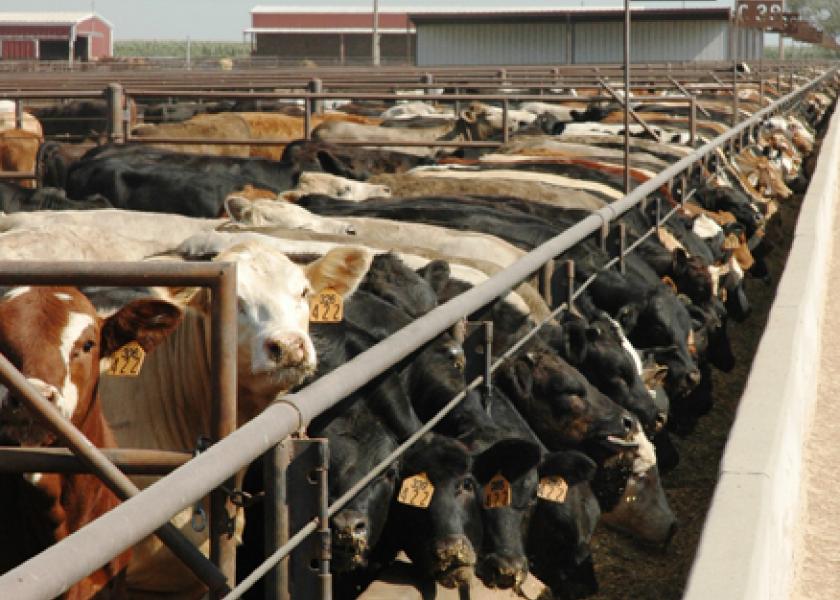Optimize Gain in Cattle

With high feed costs, every improvement in feed efficiency boosts the bottom line.
As feed costs continue to climb, feeding cattle has become a challenge and every efficiency that is gained while calves are on feed helps reduce an operation’s overall feed costs.
"With feed as high as it is right now, it’s absolutely critical to use the tools available to boost gains and efficiency," says Troy Stowater, president of Cottonwood Feeders of Stuart, Neb., and Diamond 6 Feeders of West Point, Neb. In times like these, he uses several tools to keep closeouts on cattle in the black. These include feed additives, ionophores, implants, beta agonists and overall management techniques to keep cattle comfortable and improve feed efficiency.
New feed additive options. Nutritionist Ki Fanning of Great Plains Livestock Consulting, Inc., in Eagle, Neb., sees a benefit to using feed additives to boost gains. The costs of the additives typically are more than covered by improved feed efficiency.
"One product that has some good data is Kemin’s KemTRACE chromium propionate—it increases the energy derived from feed. Two other standby products that also have good data are from Zinpro [trace minerals]and Diamond V [yeast products]," Fanning says."All three should be considered in background diets."
Research by nutritionists Brad Johnson and Bryan Bernhard at Texas Tech University indicates that steers fed chromium propionate showed an increase in average daily gain (10.8%) and feed efficiency (4.2%) as chromium propionate concentrations increased, compared to the control group. The research also found that the increased intake of chromium propionate resulted in reduced incidences of morbidity during the trial period, which would also benefit receiving rations.
There is value in feeding supplements such as chromium propionate, Stowater says. He’s seen a 4% improvement in feed efficiency at a cost of 1¢ per head per day on feed. "That takes about 4¢ to 5¢ per pound off the cost of gain. And with feed costs this high, it makes sense," he says. In addition, Johnson recommends incorporating yeast cell wall supplements in receiving rations. Based on his research on a yeast supplement from Lesaffre Yeast Corporation, he found the products increased feed intake and in some cases boosted the cattle’s immune response.
Another feed additive, ionophores, improve feed efficiency by 3% to 10% depending on the diet, Fanning says. These products target the ruminal bacterial population to improve cattle feed efficiency and reduce the risk of acidosis and bloat. This makes ionophores a good investment, since the cost of feeding is only a few cents per head per day.
Relatively new to the cattle feeder’s toolbox are beta agonists such as Optaflexx and Zilmax. These products are added to fi nishing rations during the last 20 to 40 days of feeding. These compounds are "repartitioning agents" that change the energy derived from feed, shuttling it to muscle instead of fat deposition. Research shows these products increase average daily gain and feed effi ciency anywhere from 9% to 40%.
Implants prove their worth. Implants offer a 10:1 return on investment, Fanning says. Typical implant programs in feedlot cattle can improve weight gain by 15% to 25% and feed effi ciency by 8% to 12%. Since implants tend to increase carcass weight and impact leanness, timing is important. A University of Nebraska study found that delaying the initial feedlot implant by 30 days improved marbling without impacting feedlot performance. In the study, using Synovex S, average daily gain, fi nal weight, hot carcass weight, fat thickness, ribeye area and yield grade were not affected by implant regimen. However, steers with delayed implants had higher marbling scores and percentage grading Choice (92% versus 68%).
Even with the use of all these tools, proper management and handling impacts gain efficiency and requires little investment. "The biggest thing, we believe, is to keep cattle as comfortable as possible," Stowater says. Using these tools has helped his feedyards maintain outstanding closeouts and optimize gains even during this time of record-high feed costs.







